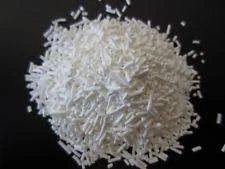
Sodium Acid Pyrophosphate - Food Additive Information
Sodium acid pyrophosphate (SAPP) is a widely used food additive known for its role as a leavening agent, stabilizer, and emulsifier in various food products. As a derivative of pyrophosphoric acid, SAPP is often categorized under phosphate food additives, which have raised concerns regarding health effects and safety. Understanding the role and implications of sodium acid pyrophosphate in the food industry is essential for both consumers and manufacturers.
One of the primary functions of SAPP is its ability to act as a leavening agent. In baked goods, SAPP reacts with baking soda (sodium bicarbonate) to release carbon dioxide, which helps to create a light and airy texture in products such as cakes, muffins, and bread. This reaction occurs in the presence of moisture and heat, making SAPP an effective option for baked goods that require a quick rise without the need for traditional yeast fermentation. Additionally, SAPP offers the advantage of being more stable than other leavening agents, allowing for longer shelf life in commercial pastries.
Beyond baking, sodium acid pyrophosphate serves various purposes in food preservation. It acts as a stabilizer, particularly in processed meats and seafood, helping to retain moisture and improve texture. By doing so, SAPP can enhance the appearance and palatability of these products, making them more appealing to consumers. Furthermore, it aids in preventing discoloration, which is especially valuable in products like potatoes and seafood.
sodium acid pyrophosphate food additive

The use of sodium acid pyrophosphate is not without controversy. Some consumers express concerns about the potential health effects associated with phosphate additives. High phosphate intake has been linked to certain health issues, including kidney disease and cardiovascular problems. However, it is essential to recognize that SAPP is generally regarded as safe when consumed within acceptable dietary limits. Regulatory agencies, including the Food and Drug Administration (FDA), have not identified any immediate health risks associated with its use in food products.
Regulation of food additives, including sodium acid pyrophosphate, is stringent. Each country has its own set of guidelines governing acceptable levels of usage and safety assessments. Manufacturers are required to comply with these regulations, ensuring that the amounts used in food products do not exceed established safety thresholds.
In conclusion, sodium acid pyrophosphate is a versatile food additive with significant roles in leavening, stabilization, and preservation. While concerns about phosphate additives persist, when used within regulated limits, SAPP is considered safe for consumption. The ongoing conversation surrounding food additives highlights the importance of consumer awareness and the need for transparency from manufacturers. As the food industry continues to evolve, understanding the nuances of ingredients like sodium acid pyrophosphate will empower consumers to make informed choices about the foods they consume.
-
Nitrile Rubber Honoring Strict Production StandardsNewsAug.22,2025
-
Aspartame Ingredients Honoring Food Safety ValuesNewsAug.22,2025
-
Fertilizer for Balanced Plant NutritionNewsAug.22,2025
-
Cyanide Gold Processing with High Purity AdditivesNewsAug.22,2025
-
Formic Acid in Textile Dyeing ApplicationsNewsAug.22,2025
-
Aluminum Hydroxide Gel in Skincare ProductsNewsAug.22,2025
-
Regulatory Compliance for Global Mining Chemicals UseNewsAug.12,2025
Hebei Tenger Chemical Technology Co., Ltd. focuses on the chemical industry and is committed to the export service of chemical raw materials.
-

view more DiethanolisopropanolamineIn the ever-growing field of chemical solutions, diethanolisopropanolamine (DEIPA) stands out as a versatile and important compound. Due to its unique chemical structure and properties, DEIPA is of interest to various industries including construction, personal care, and agriculture. -

view more TriisopropanolamineTriisopropanolamine (TIPA) alkanol amine substance, is a kind of alcohol amine compound with amino and alcohol hydroxyl, and because of its molecules contains both amino and hydroxyl. -

view more Tetramethyl Thiuram DisulfideTetramethyl thiuram disulfide, also known as TMTD, is a white to light-yellow powder with a distinct sulfur-like odor. It is soluble in organic solvents such as benzene, acetone, and ethyl acetate, making it highly versatile for use in different formulations. TMTD is known for its excellent vulcanization acceleration properties, which makes it a key ingredient in the production of rubber products. Additionally, it acts as an effective fungicide and bactericide, making it valuable in agricultural applications. Its high purity and stability ensure consistent performance, making it a preferred choice for manufacturers across various industries.





